Abstract
Digital storytelling refers to the technique of using various digital tools (a device, a web application, images, sounds, videos, etc.) in order to create digital stories. In our opinion, digital storytelling is an emerging teaching strategy because it is characterized by novelty elements; compared to classic storytelling, there is a relatively rapid increase in interest in it and has a strong impact in the context of online or/and onsite learning. Teachers can choose and create digital stories according to students’ interests. At the same time through digital storytelling, students can make sense of their own life experiences, their own knowledge and teachers get to know them better. The first part of our study presents a theoretical review regarding the usefulness of digital storytelling in Early Childhood Education. The second part shows the results of the research we have made in order to sustain the theoretical information. The purpose of our study is to identify the extent to which kindergarten educators use digital storytelling in the teaching and learning process and, at the same time, if they are aware of the importance that this strategy has for doing child centredness. In order to accomplish this, we created a questionnaire with different types of items and applied it to a number of 160 subjects, who teach in urban and rural kindergartens. By using this research tool we aimed to find answers to the question research
Keywords: Child centredness, digital storytelling, early childhood education
Introduction
Digital storytelling is a strategy that facilitates high quality reflections, as it gives children and teachers the opportunity to connect to the content of the task in a more personal way (Hamilton et al., 2019).
Digital storytelling creates a constructivist digital learning environment, where imagination, creativity, inspiration, motivation and the narrative component can offer many benefits to students, who have the opportunity to learn how to create their own digital stories, developing their written communication skills, or oral and digital, and gives teachers the opportunity to present, in a unique way, new content, making the most of collaborative learning, in which students can receive tasks related to investigating a topic, searching for meaningful images, recording the voice, and then expressing one's own point of view towards certain characters, situations, life experiences, etc. (Alismail, 2015).
Problem Statement
Storytelling has always been an important method of education for children of all cultures, so throughout evolution, since ancient Egypt, hieroglyphs symbolically described certain stories, just as the whole method is built the whole of Greek mythology (Roby, 2010).
According to research in the field of neurology, when we read or listen to stories, different parts of our brain actively follow the events of the story, as if we experienced its scenario in real life, therefore children become active participants and can contribute to the reconstruction of the narrative (O’Byrne et al., 2018). Other studies validate that the story involves areas of the brain responsible for cognitive control (Lehne et al., 2015), emotions (Hsu et al., 2015), empathy (Brink et al., 2011) and socialization (Berthoz et al., 2002). Thus, stories contribute to the construction of knowledge and to the transformation of the abstract into the concrete, by attributing meanings to imaginary, fantastic and magical contents (Isbell et al., 2004). According to Cozolino (2017), the brain develops best if four aspects are taken into account in the design of lessons:
1. teacher-child relationships are "full of support" because learning is best done in the context of secure relationships;
2. stress conditions are reduced and activated emotions are positive;
3. there is a balanced focus on thoughts and emotions;
4. stories are used creatively.
As in traditional storytelling, most digital stories focus on a specific topic, but approached through digital technologies, as the name suggests. Digital stories usually contain a mixture of computer images, text, narration, audio recordings, videos, music, etc. This is the new frontier of storytelling and is based on the combination of the art of inventing a story and the use of multimedia tools.
With a clear description, digital storytelling provokes strong emotions, so it is one of the innovative pedagogical approaches that can engage children in deep, meaningful and transformative learning, as it has become a modern approach to traditional storytelling that allows almost anyone to use various digital technologies (Movie Maker, iMovie or Photostory) to create stories using static or moving images, on a musical background, combined in accordance with the author's creativity and innovation (Smeda, Dakich, & Sharda, 2014).
Digital stories can be used in different study subjects at different age levels, but also in the case of students with hearing and visual disabilities. They can also be an effective teaching, learning, or assessment strategy for students' knowledge and skills. In order to be accessible both online and offline, digital stories can be translated into interactive digital books or digital story libraries.
Regarding Early Education in Romania, it is necessary to make a few clarifications about its’ particularities. According to the national legal framework in the field of education, represented by Law no. 1/2011, Early Education (0–6 years) covers the ante pre-school education level (3 months to 3 years) in nurseries and pre-school education level (3–6 years), in kindergartens. Nurseries offer both social and educational services, while kindergartens are part of the pre-university education system. The types of services offered by early education units are: early education services based on Curriculum for Early Education (2019) which is centred on children’s physical, cognitive, emotional, and social development At the same time, it focuses on the early remediation of potential difficulties in development; on childcare, on protection and nutrition; child health services; and offering of services for child, family, respectively counselling, parenting, and information (Ciolan et al., 2017).
Research Questions
For our study, the following research question was advanced:
Which are the benefits of using digital stories for teaching and learning process? This question can be divided into the following sub-questions:
Do kindergarten educators use digital storytelling in their daily activities? What are kindergarten teachers’ perceptions about learning through digital storytelling? In what ways does digital storytelling promote child centredness?
Purpose of the Study
The purpose of this study is to investigate the impact of digital storytelling on child centred learning. At the same time, we wanted to identify the extent to which kindergarten educators use digital storytelling in the teaching and learning process and to observe the awareness that educators have for the importance that storytelling has in child centredness.
Research Methods
Data collection tools
Although traditional storytelling has been used in Romanian kindergartens for many years, the use of this strategy represents a new challenge in teaching and learning. In order to accomplish our investigation regarding the use of this way of telling a story in early childhood education, we conducted a quantitative study with theoretical and practical implications. It involves quantitative research using questionnaire as a research tool.
Before the survey items were drawn up, the related literature was reviewed. This quantitative research presents the kindergarten educators experiences in using digital storytelling in their activities with children. The questionnaire included demographic questions, regarding respondents’ qualifications, closed-ended questions, open-ended questions, multiple-choice questions, rating scale questions and matrix questions.
Participants
Data were collected from a convenience sample made up of 160 kindergarten educators/ teachers and kindergarten head teachers. In Romania, qualification in the preschool education range from graduates of pedagogical high schools (with specializations in early childhood education and primary school education) to staff with university degrees in pedagogical studies and specializations in primary or preschool education. We selected our subjects according to the idea that a phenomenological framework must be developed through a relatively homogenous group of participants (Creswell, 2007). The participants in the phenomenological study should have significant and meaningful experiences of the phenomenon that the researchers investigate (Creswell, 2007; Moustakas, 1994). Due to the size of the sample, results apply only to the present research carried out under the specific conditions and cannot be generalized in any way (Cohen et al., 2008).
Their qualifications are represented in Figure 1. We notice that 69 percent are kindergarten teachers, 25 percent are kindergarten educators and only 6 percent are represented by kindergarten head teachers.
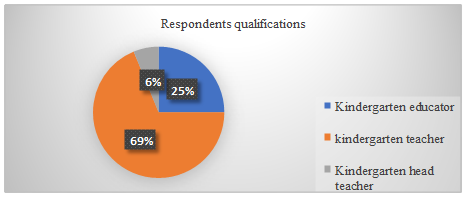
Findings
In order to accomplish our investigative approach, the first question in the questionnaire was a close-ended one. We wanted to find out if our subjects know what digital story means. Figure 2 shows that 86 percent of the respondents know what this term means and 14 percent do not know. We consider that the number of those who do not know the significance of this concept is relatively low due to the fact that during the online activities, they were not used.
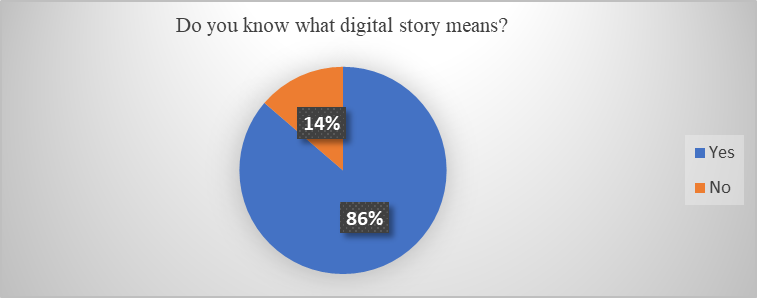
The second item was an open-ended one. Respondents had to specify where they heard about this term for the first time. Their answers were: during online teaching, in a professional meeting with colleagues, from different projects that teachers participated in, during initial training in college, in continuous professional training courses, like or on the Internet.
The benefits of storytelling are well known.
When students get involved in creating digital stories they train multiple skills, such as digital literacy by research (documentation, finding and analysis of relevant information), by writing (formulating a point of view and developing a scenario), organization (management of the project purpose, materials used and of the time required to analyze the task), technological use of a variety of instruments such as digital cameras, scanners, microphones and multimedia creation devices), expressive presentation of the story, interpersonal (teamwork and determination of individual roles for group members), problem solving (learning to make decisions and overcome obstacles) and evaluation (acquisition of expertise critical-constructive analyzing one's own work and that of others) (Robin, 2008).
In order to identify the benefits that our respondents listed regarding digital storytelling; the next open-ended question was? We have selected the most relevant answers, such as: develops creativity, engages students in the learning process, implies all the learning styles, makes students more attentive, develops communication skills Robin (2008) , develops digital skills, the presentation of the story is more interesting, develops children’s memory (Lowenthal, 2008). If the story that is being told relates to personal experiences and knowledge, then students will remember and keep information on the content they are learning for a long time. By connecting learning to their life experiences students will be engaged in the actively in the activity and in this manner, the content will be easily taught. This strategy develops logical and critical thinking, enhance curiosity, improves children’s vocabulary and free speaking, facilitates the transmission of information from the educator/teacher to preschoolers, revises knowledge from different study subjects. At the same time, children become more patient, increase their concentration and focus on learning. Sadik (2008) identified the positive impact that creating digital stories has on student motivation and engagement. As we can see, kindergarten teachers/educators identified the most important advantages that digital storytelling has in developing different types of skills for children. They also stated that this strategy helps teachers make the teaching process more atractive for children and, at the same time engages students in active learning.
The findings of a study developed by Yuksel et al. (2011) show that digital storytelling supports student understanding of different subjects related to their interests, increases academic performance, improves writing skills, develops oral communication abilities and research skills. In addition to these, the results confirm that students demonstrate critical thinking, a higher capacity of interaction with peers, make them to reflect on their activities. The artistic skills are also developed when teachers use digital storytelling in the activities with students.
Further, teachers had to rate the advantages of digital storytelling using a scale of 1 to 5, with 1 meaning ‘strongly disagree’, and 5 meaning ‘strongly agree’. In this case, we provided a list of six main benefits and they had to order them according to the importance they give to each aspect. The results are showed in Figure 3.
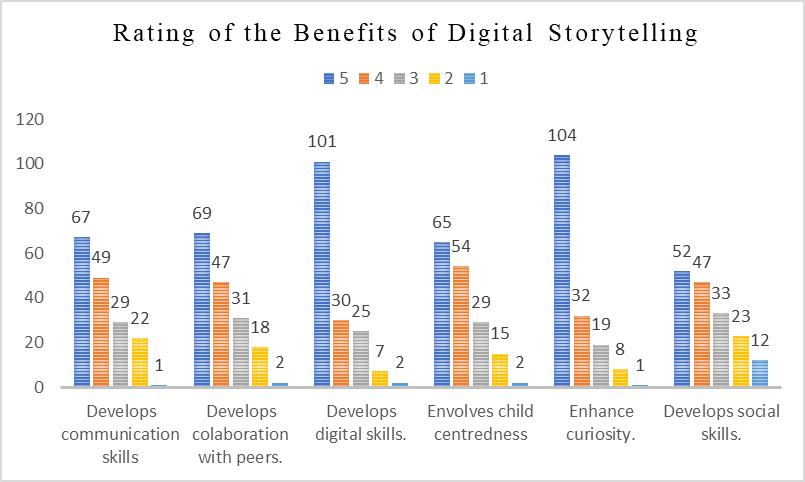
The results indicate that according to 104 respondents, digital storytelling enhances curiosity in a very high rate. 101 subjects consider that digital storytelling develops digital skills that’s why they rated this benefit with 5 points.
As our study aims to investigate the way in which teachers can use digital storytelling to centre their teaching activities on the child, we were interested in finding out how this aspect was rated by our respondents. So, as we can see, 65 of them rated this with 5 points, 54 with 4 points, 29 with 3 points, 15 with 2 points and 2 with one point. At the same time, we consider that all the other indicators that we have listed can be included in the child centred approach.
The following question was a verification one:? 84.4 percent responded affirmatively and 16.6 percent, negatively. Figure 4 presents the percentage of the population.
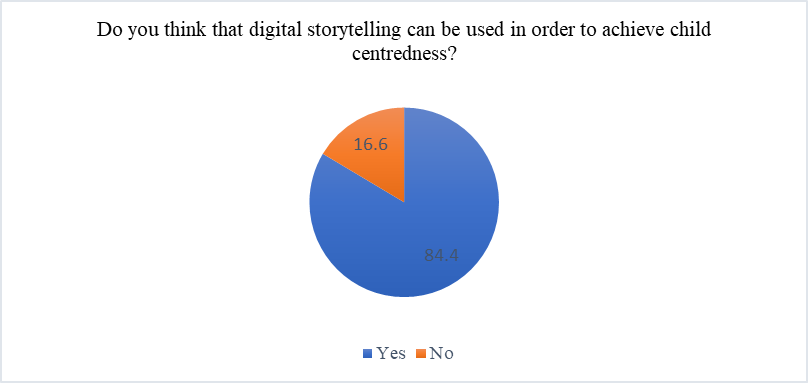
Sadik (2008) developed a study with 280 students aged 6 to 15, during three months in two private schools in Qena, Egypt. The results showed that students stayed engaged in the activity if they were actively engaged in the process of learning, using storytelling. The next open-ended question requested the subjects to identify the concrete ways in which the teacher can achieve child centeredness by using digital storytelling. The most common answers were: focusing learning topics on children’s points of interest, adapting the content to children’s individual characteristics, creating stories for therapy, using the child as a main character in a story, giving the opportunity for the children to create stories and to choose their favourite subjects, by individualizing and differentiating the learning contents, creating digital stories about different problems that children have during different activities and trying to solve these problems through digital stories, using different applications and educational software,
Due to the fact that kindergarten educators/teachers are the most capable adults to use digital stories in activities with children, we used a close-ended question to find out the manner in which they have confidence in children’s digital skills. So, the question was:? Figure 5 represents the degree of confidence: 70 percent of them answered that they agree that children could be capable of creating digital stories, and 30 percent of them do not agree.
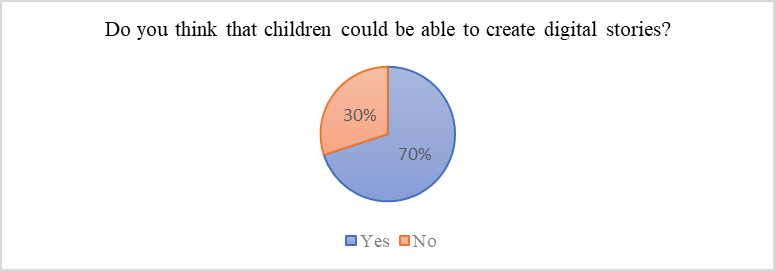
However, all the respondents argued that children can create digital stories in the following ways:
By asking an adult for help;
Digitizing children’s drawings;
Telling a story about their digital drawings or paintings;
In the freely chosen and self-directed activities;
Recording children’s stories;
Creating group stories on different topics of interest;
In the freely chosen and self-directed activities;
Creating PowerPoint presentations during daily activities;
Creating a story starting from a given picture;
Using Scratch App etc.
For the next question we wanted to find out which are, in teachers’ opinion, the type of activities which are best opportunities to use digital storytelling. In Romania, the Early Childhood Education Teaching Plan contains three categories of learning activities: freely chosen activities, experiential domains activities and personal development activities. Freely chosen activities refers to all play-based or learning-based activities that teachers develop in the daily program, especially the learning centers. The experiential domains activities are represented by different learning activities according to the educational fields: Science, Mathematics, Language Development, Arts, Music and Physical Activities. Personal development activities relate to different routines, including Morning Meeting and transitions-short activities that ensure passage from one activity to the next.
Aiming to find out which are the educational uses of storytelling in kindergarten daily activities, the next questions have provided us with the following answers, as it may be seen in the Figure 6.
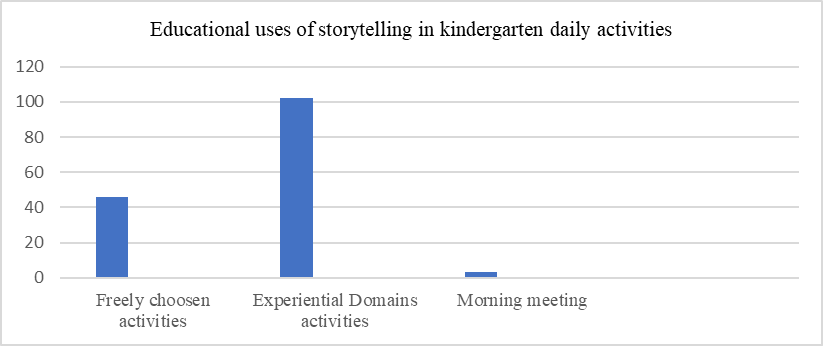
In the end, we asked our respondents to define digital story. The most relevant definitions were the following:
a "living story", where reading, images and hearing are so harmoniously combined, on a phone screen, tablet, laptop or another digital device;
that story that can combine still images, moving images, sound and text, as well as be non-linear and contain interactive features;
a story whose content and format is designed to facilitate learning;
much more interactive and creative stories that children really need;
a set of images, videos, drawings that ultimately constitute a logical and chronological succession of ideas in order to facilitate and help towards a better understanding of a classic story. At the same time, these stories have an important role in the development of children in various fields.
story created by educators or children, based on suggestions, ideas, digitally transposed, using images / purposes created by children, or the child's voice can be used;
represents the narrative that is transmitted through technological means (laptop, computer), which arouses curiosity and interest in the preschooler, through the way it is played.
interactive story created on the basis of a drawing, using static images or moving images, sound and text, unconventional, which allows its sharing, using the Internet.
Because we consider that digital storytelling may become one of the most powerful instructional tool aimed to enhance curiosity and centre the process of teaching and learning on the child, we introduced the last question in order to find out if the teachers would be interested in being part of a project regarding this field. 88 percent agreed, and 12 percent did not. Figure 7 presents the results.
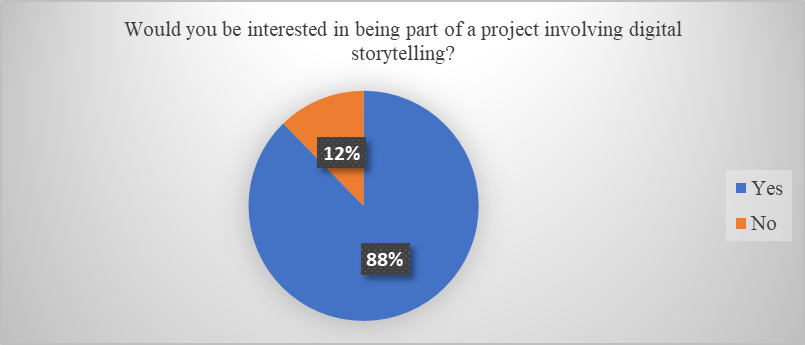
Conclusion
Our study contributes to the literature on using eLearning during early childhood education as we consider that using digital storytelling has a lot of benefits for children’s development. All the researchers that we mentioned in the study acknowledge and promotes the multiple advantages of this strategy, so it supports to the literature in terms of suggesting a new teaching strategy by using the proper technological tools.
Teachers today need to move forward with technology and use it to create an interesting way of learning for their students. Today, children are digital natives and this is the reason why teachers must use digital tool that motivates them in order to become enthusiastic about the process of learning. (Clemens & Kreider, 2011; Sylvester & Greenidge, 2011). When teachers use this kind of tools, they develop 21st century literacy skills that students will need to be successful as future adults in a challenging society. (Sadik, 2008; Sylvester & Greenidge, 2011).
The study has some limitations, like subjectivity of teachers’ responses, limited sample size, sample heterogeneity and lack of a control group in the conditions of the research are defined as inherent constraints of our study.
Acknowledgments
The following paper has been developed in the Child-Centred Competences for Early Childhood Education and Care project (Erasmus+ Key Action 203 Mobility Project: 2019-1-UK01-KA203-061665).
References
Alismail, H. A. (2015). Integrate Digital Storytelling in Education. Journal of Education and Practice, 6(9), 126-129. https://files.eric.ed.gov/fulltext/EJ1082416.pdf
Berthoz, S., Armony, J. L., Blair, R. J. R., Dolan, & R. J. (2002). An FMRI study of intentional and unintentional (embarrassing) violations of social norms. Brain 125, 1696–1708.
Brink, T. T., Urton, K., Held, D., Kirilina, E., Hofmann, M., Klann-Delius, G., Arthur M. J., & Kuchin, L. (2011).The role of orbitofrontal cortex in processing empathy stories in 4-to 8-year-old children. Front. Psychol, 2(80).
Ciolan, L., R. Iucu, A., Petrescu, & C. Bucur. (2017). Romania – ECEC Workforce Profile. In Workforce Profiles in Systems of Early Childhood Education and Care in Europe, edited by P. Oberhuemer and I. Schreyer. www.seepro.eu/English/Country_Reports.html
Clemens, S., & Kreider, M. (2011). What's your story? Using digital storytelling to enhance 21 st Century Skills. Retrieved on July, 9 from www.ucdenver.edul/chapter11.pdj
Cohen, L., Manion, L., & Morrison, K. (2008). Research Methods in Education, 170. Retrieved from: https://gtu.ge/Agro-Lib/RESEARCH%20METHOD%20COHEN%20ok.pdf
Cozolino, L. (2017). Predarea bazată pe atașament. Cum să creezi o clasă tribală [Attachment-Based Teaching: Creating a Tribal Classroom]. București: Editura Trei.
Creswell, J. W. (2007). Qualitative inquiry and research design: Choosing among five traditions (2nd Ed). Sage Publications, Inc. Retrieved from https://psycnet.apa.org/record/2006-13099-000
Hamilton, A., Rubin, D., Tarrant, M., & Gleason, M. (2019). Digital storytelling as a tool for fostering reflection. Frontiers: The Interdisciplinary Journal of Study Abroad, 31(1), 59-73.
Hsu, C. T., Jacobs, A. M., Citron, F. M., & Conrad, M. (2015). The emotionpotential of words and passages in reading Harry Potter–An fMRI study. Brain Lang, 142, 96–114.
Isbell, R., Sobol, J., Lindauer, L., & Lowrance, A. (2004).The effects of storytelling and story reading on the oral language complexity and story comprehension of young children. Early Child. Education, 32. 157–163.
Lehne, M., Engel, P., Rohrmeier, M., Menninghaus, W., Jacobs, A. M., & Koelsch, S. (2015). Reading a suspenseful literary text activates brain areasrelated to social cognition and predictive inference, PLoS One, 10(5).
Lowenthal, P. R. (2008). Digital storytelling: An emerging institutional technology?.Retrieved from https://www.researchgate.net/publication/265450866_Digital_storytelling_An_emerging_institutional_technology
Moustakas, C. (1994). Phenomenological research methods. Sage. Myers. Retrieved from https://books.google.es/books?hl=ro&lr=&id=pp11AwAAQBAJ&oi=fnd&pg=PP1&dq=Moustakas,+C.+(1994).+Phenomenological+research+methods.&ots=O9Q70vKuI&sig=nNLW0GcMMvf55K0IT4tYW8Nzwo#v=onepage&q=Moustakas%2C%20C.%20(1994).%20Phenomenological%20research%20methods.&f=false
O’Byrne, W. I., Stone, R., & White, M. (2018). Digital Storytelling in Early Childhood: Student Illustrations Shaping Social Interactions. Frontiers in psychology, 9, 1800.
Robin, B. (2008). Digital storytelling: A powerful technology tool for the 21st century classroom. Theory Into Practice, 47, 220-228.
Roby, T. (2010). Opus in the Classroom: Striking CoRDS with Content-Related Digital Storytelling. Contemporary Issues in Technology and Teacher Education, 10(1), 133-144. Retrieved from: https://www.learntechlib.org/primary/p/32348/
Sadik, A. (2008). Digital Storytelling: A meaningful technology-integrated approach for engaged student learning. Educational Technology Research and Development, 56(4), 487-506. https://doi.org/10.1007/s11423-008-9091-8
Smeda, N., Dakich, E., & Sharda, N. (2014). The effectiveness of digital storytelling in the classrooms: A comprehensive study, Smart Learning Environments, 1(6), 1-21.
Sylvester, R., & Greenidge, W. (2011). Digital Storytelling: Extending the Potential for Struggling Writers. The reading teacher.
Yuksel, P., Robin, B., & McNeil, S. (2011). Educational Uses of Digital Storytelling all around the World. In M. Koehler & P. Mishra (Eds.), Proceedings of SITE 2011--Society for Information Technology & Teacher Education International Conference (pp. 1264-1271). Nashville, Tennessee, USA: Association for the Advancement of Computing in Education (AACE). Retrieved from from https://www.learntechlib.org/p/36461
Copyright information

This work is licensed under a Creative Commons Attribution-NonCommercial-NoDerivatives 4.0 International License.
About this article
Publication Date
23 March 2022
Article Doi
eBook ISBN
978-1-80296-955-9
Publisher
European Publisher
Volume
2
Print ISBN (optional)
-
Edition Number
1st Edition
Pages
1-803
Subjects
Education, Early Childhood Education, Digital Education, Development, Covid-19
Cite this article as:
Catalano, H., & Catalano, C. (2022). Using Digital Storytelling In Early Childhood Education To Promote Child Centredness. In I. Albulescu, & C. Stan (Eds.), Education, Reflection, Development - ERD 2021, vol 2. European Proceedings of Educational Sciences (pp. 169-179). European Publisher. https://doi.org/10.15405/epes.22032.16

